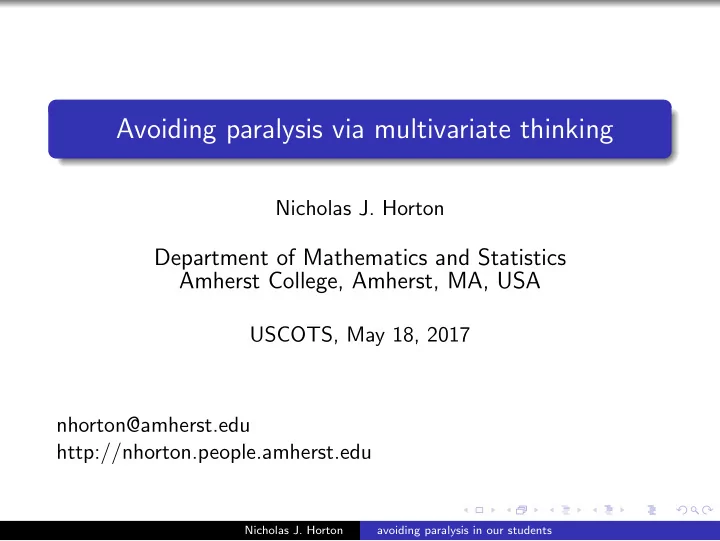

Avoiding paralysis via multivariate thinking Nicholas J. Horton Department of Mathematics and Statistics Amherst College, Amherst, MA, USA USCOTS, May 18, 2017 nhorton@amherst.edu http://nhorton.people.amherst.edu Nicholas J. Horton avoiding paralysis in our students
Potential paralysis? Wild: glimpses of a multivariate world Nicholas J. Horton avoiding paralysis in our students
Potential paralysis? Wild: glimpses of a multivariate world Question: do we reinforce key aspects of design (observational data vs. randomized trials) when we teach inference? Nicholas J. Horton avoiding paralysis in our students
Potential paralysis? Wild: glimpses of a multivariate world Question: do we reinforce key aspects of design (observational data vs. randomized trials) when we teach inference? Do students infer that they can’t make inferential conclusions if data don’t arise from a randomized trial? Nicholas J. Horton avoiding paralysis in our students
Potential paralysis? Wild: glimpses of a multivariate world Question: do we reinforce key aspects of design (observational data vs. randomized trials) when we teach inference? Do students infer that they can’t make inferential conclusions if data don’t arise from a randomized trial? What are implications in a world of found data? Nicholas J. Horton avoiding paralysis in our students
SAT scores and teacher salaries (state data from 2010) Nicholas J. Horton avoiding paralysis in our students
SAT scores and teacher salaries (state data from 2010) Nicholas J. Horton avoiding paralysis in our students
Multivariate thinking and confounding Nicholas J. Horton avoiding paralysis in our students
stratification and/or multiple regression: Obama’s 2016 single author JAMA paper Nicholas J. Horton avoiding paralysis in our students
Example from SDM4 (De Veaux, Velleman, and Bock) p. 575 Exercise 20.41: It’s widely believed that regular mammogram screening may detect breast cancer early, resulting in fewer deaths from that disease. One study that investigated this issue over a period of 18 years was published during the 1970’s. Among 30,565 who had never had mammograms, 196 died of breast cancer (0.64%) while only 153 of 30,131 who had undergone screening died of breast cancer (0.50%). Do these results suggest that mammograms may be an effective screening tool to reduce breast cancer deaths? Nicholas J. Horton avoiding paralysis in our students
Solution to Exercise 20.41 SDM4 (De Veaux, Velleman, and Bock) p. 575 H 0 : p 1 − p 2 = 0 vs. H A : p 1 − p 2 > 0 (one-sided test? That’s a different sermon.) Nicholas J. Horton avoiding paralysis in our students
Solution to Exercise 20.41 SDM4 (De Veaux, Velleman, and Bock) p. 575 H 0 : p 1 − p 2 = 0 vs. H A : p 1 − p 2 > 0 (one-sided test? That’s a different sermon.) where p 1 is the proportion of women who never had mammograms who died of breast cancer and p 2 is the proportion of women who had undergone screening who died of breast cancer (z=2.17, p=0.0148). With a p-value this low, we reject H 0 . The data suggest that mammograms may reduce breast cancer deaths. Nicholas J. Horton avoiding paralysis in our students
Solution to Exercise 20.41 SDM4 (De Veaux, Velleman, and Bock) p. 575 H 0 : p 1 − p 2 = 0 vs. H A : p 1 − p 2 > 0 (one-sided test? That’s a different sermon.) where p 1 is the proportion of women who never had mammograms who died of breast cancer and p 2 is the proportion of women who had undergone screening who died of breast cancer (z=2.17, p=0.0148). With a p-value this low, we reject H 0 . The data suggest that mammograms may reduce breast cancer deaths. (But what about possible confounders?) Nicholas J. Horton avoiding paralysis in our students
(Non-scientific) survey of isolated statisticians and Stat Ed section members question: “what assumptions do you have students check when using the two sample t-test?” Nicholas J. Horton avoiding paralysis in our students
(Non-scientific) survey of isolated statisticians and Stat Ed section members question: “what assumptions do you have students check when using the two sample t-test?” representative answer: (instructor using Gould and Ryan [first edition]) 1 Randomness in the data collection process (either random samples or experiment ) 2 Independent samples 3 Either normal looking samples or sample sizes larger than 25 Nicholas J. Horton avoiding paralysis in our students
(Non-scientific) survey of isolated statisticians and Stat Ed section members question: “what assumptions do you have students check when using the two sample t-test?” representative answer: (instructor using Gould and Ryan [first edition]) 1 Randomness in the data collection process (either random samples or experiment ) 2 Independent samples 3 Either normal looking samples or sample sizes larger than 25 What about possible confounders? (Only one other respondent out of more than 20 mentioned “random assignment”: almost all emphasis was on technical conditions). Nicholas J. Horton avoiding paralysis in our students
AP Computer Science Principles: an end-run around intro stat? Nicholas J. Horton avoiding paralysis in our students
AP Computer Science Principles: taught for first time this year Nicholas J. Horton avoiding paralysis in our students
AP Computer Science Principles: project based learning Nicholas J. Horton avoiding paralysis in our students
AP Computer Science Principles: 200 page course description Nicholas J. Horton avoiding paralysis in our students
Closing thoughts Teach (modern) design early and often Avoid paralysis: teach techniques to move beyond two-sample t-test (stratification and multiple regression) Make room by simplifying (what if all datasets were n > 100?) Show me the data: communicate the excitement of statistics as a way to extract meaning from data Nicholas J. Horton avoiding paralysis in our students
Recommend
More recommend